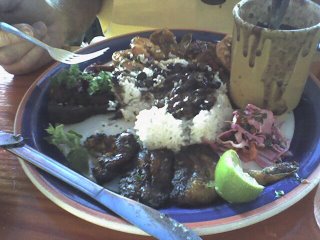A true American cuisine
 I spent the day in Seattle yesterday. At lunchtime, I popped into a sushi bar in the middle of a strip mall in Kirkland and immediately soaked up the Japanese ambiance. I have really enjoyed Tokyo and Kyoto on my trips to Japan, and bide my time before my putative return there with Japanese mystery novels and the occasional visit to Japanese restaurants.
I spent the day in Seattle yesterday. At lunchtime, I popped into a sushi bar in the middle of a strip mall in Kirkland and immediately soaked up the Japanese ambiance. I have really enjoyed Tokyo and Kyoto on my trips to Japan, and bide my time before my putative return there with Japanese mystery novels and the occasional visit to Japanese restaurants.At first I was put off by the Americana on the menu. The chef has created sushi menu items inspired by his many trips around the U.S. My choice ended up being the Arizona highway themed Cactus Sushi, which was made up of a tower of stacked sushi rolls accompanied by another shorter tower, each doused with crunchy green shavings of flash cooked spinach juice. It was as Japanese food always is, pretty, and happily also delicious.
Then I had a very pleasant taxi ride to Sea-Tac, with a driver from Pakistan who had lived in Seattle for what must have been more than 20 years. He told me his life story on the long ride from Kirkland to the airport, and suffice it to say he is the quintessential "millionaire next door," a real American success story. As we approached the airport we got into a lively discussion on curry and I took with me a couple of ideas I could try at home. This conversation reminded me of one I had years ago in Verona, Italy with a group of Italian business men during a lunch. The conversation veered from local politics, to business management theory, to different types of Italian pressed meats. At the time, I quietly observed how food was so central to the culture that even business men would discuss at length amongst themselves about the history, tradition and flavor of a local speciality.
And I got to thinking. What is American cuisine, or cooking if you take the view we don't have a cooking culture sophisticated enough to call a veritable cuisine? Do we have a food culture?
Back in the day, it was about filling up with apple pie, fried chicken, hamburgers, macaroni and cheese and ice cream. Where were the vegetables? Usually canned and disgusting. Now, I've seen a throwback to some of these traditional foods, but they are usually modernized into gourmet versions, e.g. organic, imported macaroni with fontina, gorgonzola, gruyere and the like. It is a weak kind of rebranding, really, as the dish isn't any healthier it just tastes different and costs more. It has gone "premium" as so many brands try to go in order to revive themselves.
And so much immigration has affected what we eat, but in terms of ethnic culinary enclaves like Mexican, Chinese, and Greek restaurants, the pervasiveness of pizza, and the presence of lots of heat in dishes we like to dig into. Lately there has been a profusion of a kind of tropicalismo, and a new profusion of Latin American eateries in Portland such as Oba!, Andina and Pambiche, as this photo of beans, rice and fried plantains will testify.

I don't think there is a bona fide American cuisine. I do think in the Pacific Northwest we are developing an ethos, style, integrity of ingredients that could develop into something akin to a cuisine. Like French waiters and chefs who become indignant at rubes who ask for ketchup for their filet mignon, PNW foodies take pride in demanding locally grown, seasonal, organic food that is unpretentious, healthy and aesthetically pleasing in its balance of ingredients. Like my cab driver, virtually anyone you meet here will quite quickly jump into a conversation about food as a subject that really matters. As my friend, chef and culinary educator Robert Reynolds has said, Oregon could be the new France. We have everything to make it so. A real American cuisine has to first be based in values such as these in order to evolve. It will not be an amalgam or fusion of Thai this and Mexican that. It will be something original and grounded in what is natively ours.

0 Comments:
Post a Comment
<< Home